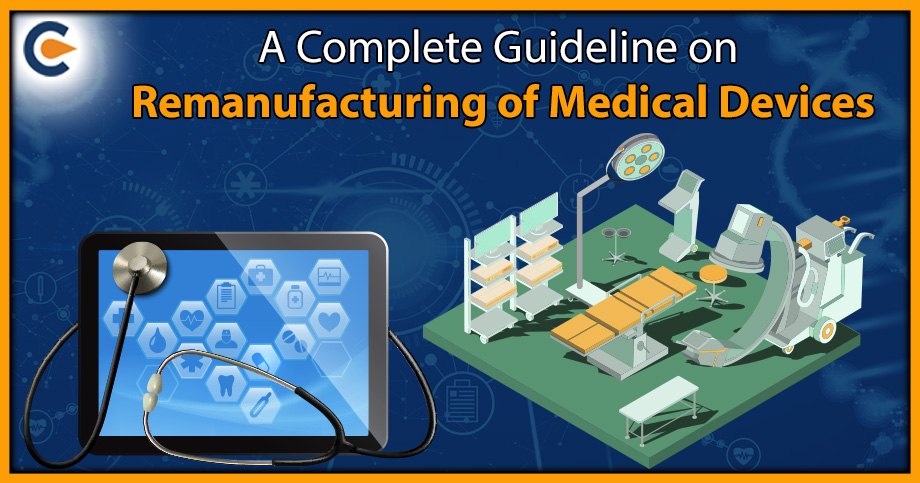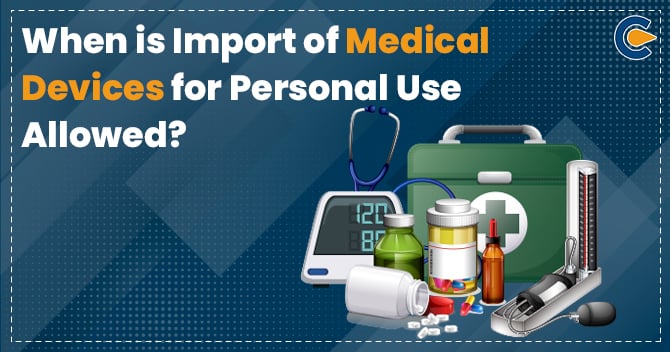As per the draft guidelines laid down by FDA (Food and Drugs Administration), “Remanufacturing” is defined as the process, conditions, refurbishes, replenishing, restoring or any other related act done towards the completion of final device that significantly changes the finished devices performance and conduct or safety specification on intended use. In order to help ensure the continuous quality, safety, and effectiveness of devices that are designed to be serviced throughout the course of their useful life, remanufacturing of devices in the medical industry is an important tool for the manufacturer. Remanufacturing of devices using technologies can lead to amelioration in various developing countries. In this article, we shall discuss the concept of Remanufacturing of medical devices, Medical Goods that can remanufactured, when it is done and what is the significance of remanufacturing? A detailed discussion on the FDA issued guidelines on Remanufacturing of medical devices.
The effect of Remanufacturing on sustainability was assessed in the light of numerous socio-economic conditions and as a result, single-use medical devices were found to be very essential for reduction in Waste Management in the medical industry. The COVID-19 pandemic has increased the use of single-use devices, making this even more important. Cleaning was considered to be an important factor in providing a secure and reliable remanufacturing process that would mitigate the risk of contamination to patients. As a result, this procedure was scrutinized and sensible suggestions were offered henceforth.
Medical Goods That Are Eligible For Remanufacture
Both the list of products that can be remanufactured and the regulations governing what can and cannot be remanufactured are open to interpretation. Remanufacturing, however, functions best in the following areas: High-end, sophisticated products that are not sold on the basis of a consumer’s status or way of life.
The list of remanufactured medical goods is mentioned below:
- Surgical instruments such as Clamps and Forceps,
- Endoscopes such as Bronchoscope, Duodenoscopies, and Colonoscopies, equipment that is used for visualization inside the body,
- Accessories for the endoscope, such as graspers and scissors,
- Laparoscopic surgery accessories such as arthroscopic shavers
The draft guidelines offer a flowchart outlining the methodology to be used and the factors to be taken into account to help medical device manufacturers determine whether a specific activity falls under the definition of “remanufacturing.” The flowchart suggests that each modification (such as a physical change or modification to a safety control) be evaluated separately to ascertain whether the activity is likely to be remanufactured. A comparison to a medical device that has already been released on the market should be made in order to assess the impact that the changes have had. All decisions made should be supported by adequate documentation.
Documents Required For the Remanufacturing Of Medical Devices
The authority also highlights the need for documentation of the decision-making procedure itself.
The documentation for the remanufacturing of Medical Devices should contain the following, as per the instructions:
- Product name (if the relevant, model number and serial number);
- Date of completed activities, evaluation, and determination;
- Describe the gadget;
- A description of the tasks to be completed, along with a list of the materials, parts, and components that will be used;
- Deciding if a particular operation is remanufacturing;
- Citation of pertinent documents that help the decision-making process.
Process for Remanufacturing of Medical Devices
The remanufacturing of Medical Devices is generally divided into a six-stage procedure. These include:
- Component remanufacturing,
- Testing,
- Assembling
- Disassembling
- Cleaning, and
- Inspection
Each of these areas is essential to the overall process of remanufacturing of medical devices because it guarantees that a particular product will be rebuilt to a high standard and that the proper quality control measures will be put in place at each stage. Due to the high standards expected in the medical profession, the “Cleaning” stage was chosen to be of the most demanded step for further remanufacturing. Although the cleaning procedure is crucial for the medical industry as a whole, considering single-use medical devices makes its significance even more apparent. Single use products in the medical sector can be used only once as the name depicts, and then it is to be disposed of, this does not sounds so effective from a sustainable point of view. Thus, remanufacturing of devices holds a very crucial place in the medical industry.
Remanufacturing of Medical Devices is a six-step process, as laid down by the guidelines of the FDA. The “cleaning” phase is crucial when it comes to medical devices. This is due to the fact that the most, if not all, medical devices require sterilization. As parts can be clean but not sterile, sterilization is more industry-specific. When an equipment is sterilized, it is made sure to be clean and devoid of any microbes, such as bacteria or viruses.
Sterilization[1] is a crucial factor to take into account while remanufacturing medical equipment. The remanufacturer of the equipment must take into account the material’s potential short- and long-term changes, its absorbency, if the sterilization procedure impacts the device’s intended use, and whether the sterilization process will touch all contaminable parts of the item. The time and expense associated with this portion of the remanufacturing of medical equipment could be decreased with the introduction of strict sterilizing procedures in any remanufacturing laws.
The Food and Drug Administration (FDA) has highlighted a number of actions taken on software that are probably not considered for “Remanufacturing”, because they generally do not significantly modify the performance or safety parameters of the medical device,
- Actions taken on behalf of or in any other way expressly approved by the Original Equipment Manufacturer(OEM) that restore the legally sold product to its performance and safety specifications, as well as its intended use;
- Implementing the updates and upgrades offered by the OEM;
- Running hardware diagnostics using software;
- Checking for malware, viruses, and other cybersecurity-related problems;
- Reinstalling Original Equipment Manufacturer(OEM) software to bring performance and safety back to their former levels;
- Software that returns to a previous configuration;
- Installing security upgrades that the Original Equipment Manufacturer(OEM) has approved;
- Evaluating the software inventory, gathering system logs, managing user accounts, and getting access to repair and diagnostic data.
FDA’s Guidance on the Remanufacturing of Medical Devices
These six (6) guiding principles are included in the FDA’s guidance on the remanufacturing of medical devices and are intended to help establish if an entity’s activities are valid.
- Check to see if the intended use has changed.
- Ascertain if the individual and combined effects of the actions significantly alter the safety or performance requirements of a final product. The FDA states that it considers improvements to a device to be a “change.” Multiple adjustments should be assessed since, when taken together, they may dramatically alter the device’s performance or safety requirements.
- In accordance with FDA’s guidance, determine whether any changes to a device necessitate a new marking submission, analyze the dimensions of a component, part, or substance.
- Analyze the dimensions and performance requirements for the component, part, or material.
- Use a risk-based approach to decide whether a task qualifies as manufacturing if it significantly alters performance or safety requirements.
- Maintain adequate records of decisions made in order to support them in the event that an FDA inspection occurs. The documentation should specifically state whether or not the actions taken in relation to the device materially alter its intended usage, performance, or safety requirements. Appendix B of the draft guidance contains examples of this material provided by FDA.
Suggestions – Remanufacturing of Medical Devices
When a medical device is considered to be “remanufacturing,” all of the duties of a medical device manufacturer are taken into account, such as:
- In case a advanced and updated marketing submission is necessary;
- In the case, the Original Equipment Manufacturer(OEM) or the remanufacturer learns of a reportable incident, Medical Device Reporting (MDR) is required;
- Listing and Registering of the medical devices is a necessary;
- Quality System Regulation (QSR) conformity. It is also known as FDA 21 CFR Part 820, is a system that assures that the medical device meets the safety and quality standard prerequisite. These system are in currently in trend and is called as Current Good Manufacturing Practices (CGMP).
- Obligations for removals or corrections and reporting; and
- General rules against adulteration and misbranding
Conclusion
To conclude we can say, both ‘Remanufacturing’ and ‘Servicing’ procedures ultimately aim to restore a medical device to its performance and safety standards specified by the authentic equipment manufacturer. There is a requirement of medical device regulation. The main goals of regulation are to prevent access to harmful products and to provide patients with high quality, safe & sound and effective medical devices. The enactment of strict regulation ensures betterment and benefit to public health as well as security of patients, medical personnel, the general public and other communities, when it is properly applied.
Read Our Article: A Step By Step Guide For Registration Process For Medical Devices In India













